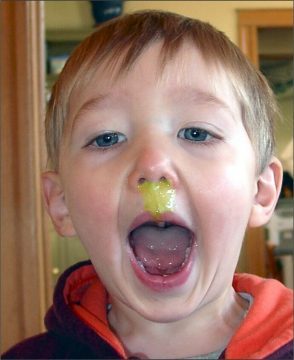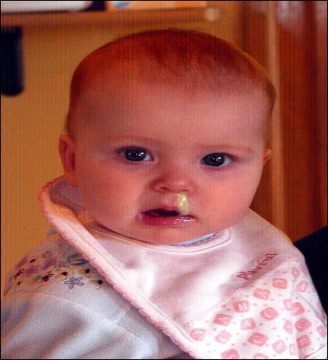Working as an early learning professional can be rewarding and downright fun when things are flowing. We all have those days when we feel capable, competent, and on top of our game. Then there are the other times. The times when the Snoterpillars attack:

Snoterpillar Attack
[Setting: family child care program on a warm spring day about 2006]
We’re enjoying a morning snack of homemade banana bread–still warm from the oven–and milk. Things are fine until one-year-old Sam sneezes. I look just in time to see them appear: two big, thick, green snoterpillars stretching from his nose to his upper lip. They gaze at me across the table, quaking as Sam gnaws away at a hunk of banana bread, crumbs flying everywhere and sticking to the thick ropes of snot.
He’s oblivious to their existence, as are the other kids.
I’m about to vomit in my mouth.
I turn to grab a tissue as I hear him cough. Most of the time he coughs with a wide-open mouth, so I expected to see banana bread spraying out of his face as I turned back to the table.
What I saw was much worse. He had coughed with his mouth closed, expelling air from his nose and ballooning the two Snoterpillars into giant, glistening, translucent snot bubbles covered in banana bread crumbs.
I stood there, tissue in hand, unable to move. I was repulsed, but I couldn’t look away. I was disgusted, but mesmerized. In my head, time stood still for an eternity, but the bubbles lasted less than a second. Sam inhaled and sucked them back into his cute little nose with a gurgling snort.
Then he sneezed again.
This time the Snoterpillars stretched beyond his chin. The site paralyzed me and is forever burned into my memory.

Man Of Action
But I’m a man of action: I shook free of my momentary paralysis and shoulder-rolled across the table with an outstretched tissue in one hand and my trusted photon-powered-sanitizing-space-blaster in the other. With a single practiced flip of the wrist, I captured the attacking Snoterpillars in mid roll landing silently on the other side of the room.
The kids ate on–unaware I had just saved all of them…and possibly the world…from the evil invaders.
With a far off look in my eye, I shed a single tear as I disposed of the Snoterpillar remains.
(I’ve been told by my wonderful wife, Tasha, that the above story may be a bit exaggerated, but we all experience and remember things in our own way. I stand by my memory of the event.)
We Get To The Point
“So”, you may be thinking, “what’s the point of this lovely tale of snot and banana bread?”
Well, the point is that most of us have things about our careers as caregivers that get to us. Things that make us contemplate how we ended up in this profession and wonder why we stay. Things that get under our skin. These things are different for each of us and can be very personal. The stuff scratching ferociously at my last nerve may not bother you at all. Years ago I started referring to all these things as Snoterpillars.
The long hours, the noise, the regulations, the isolation and other downsides of working in early learning never bothered me as much as the stuff that leaked, squirted, plopped, oozed, dripped, and sprayed out of the kids. The diaper blowouts, the drool, and the Snoterpillars are what stressed me out. In over 26 years as a caregiver, I never really got comfortable with all the icky stuff.
These annoyances may not gnaw at us daily, but they do pop up now and then when other bits of our day are not going quiet right, or when we’re exhausted, or when we’ve been ignoring our own needs.
The things that get under your skin impact how you do the job. If you let them, they will affect your relationships with the children in care and the quality of your early learning environment.

What Gets Under Your Skin?
To be fully tuned in for the children it helps to know what gets under your skin—to know your Snoterpillars. In trainings I do on caregiver stress and burnout, I suggest attendees make a complete and specific list of the things that get under their skin. Investing time in creating such a list pays off because it forces you to think about what bothers you and give names to feelings that are often effervescent. It’s also helpful because identifying your Snoterpillars gives you power and control over them. This makes it harder for them to sneak up on you—and that means you can develop strategies for dealing with them more effectively.
Contemplate Strategies
After you’ve identified your Snoterpillars, spend a bit of time contemplating strategies you can employ when you’re attacked. My biggest problem was that all the stuff leaking and dripping from the children made my stomach churn. What was my answer?
We’ll, first I got in the habit of giving others every chance to handle the icky stuff since most of them had a higher tolerance for all the ooey-gooey ickiness. Too often, I pretended not to see the snot or smell the diaper-in-need-of-changing. Upon reflection, I know that was not the most honorable choice and makes me look like a jerk. But in my defense, I’d try to bring things back into balance by dealing with the stuff that got under their skin—like all the “why?” questions the three-year-olds asked, grouchy parents, and unhappy infants. My skin was pretty thick when it came to such things.
I eventually mostly outgrew the “let someone else deal with it” strategy. After that, I chose to look at all the snot, poo, and drool as invading alien life forms out to take over our solar system…and myself as a superhero protecting humankind. It sounds silly, but it worked.
The point is to devote some thought to how you’ll handle your Snoterpillars before they attack. I’m sure your strategies will be better than mine.
Take Care Of Yourself
Another way to battle your Snoterpillars is to make more time for your own needs. A lot of people in this profession get so wrapped up in caring for others that they neglect themselves. This can lead to heaps of unhealthy stress–and that stress can lead to burnout. It’s hard to do, but even committing 5 to 10 minutes each day to a bit of self-care can be beneficial.
What do you do with that time?
Something that fills you up. Something that centers you. Something that helps you feel calm and focused. Starting out the day with a bit of self-care can do wonders when it comes to fending off the Snoterpillars. If you’re more focused and centered when they attack, you’ll respond more mindfully.
Wrapping It Up
We can’t avoid Snoterpillar attacks, but with a bit of preparation we can prepare for them and diminish their power.
Let us know what get’s under your skin about early learning, and how you battle it, in the comments.
Post Author
Jeff Johnson is an early learning trainer, podcaster, and author who founded Explorations Early Learning, Playvolution HQ, and Play Haven.

Leave a Reply